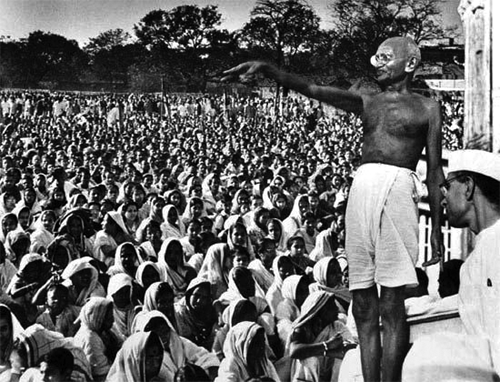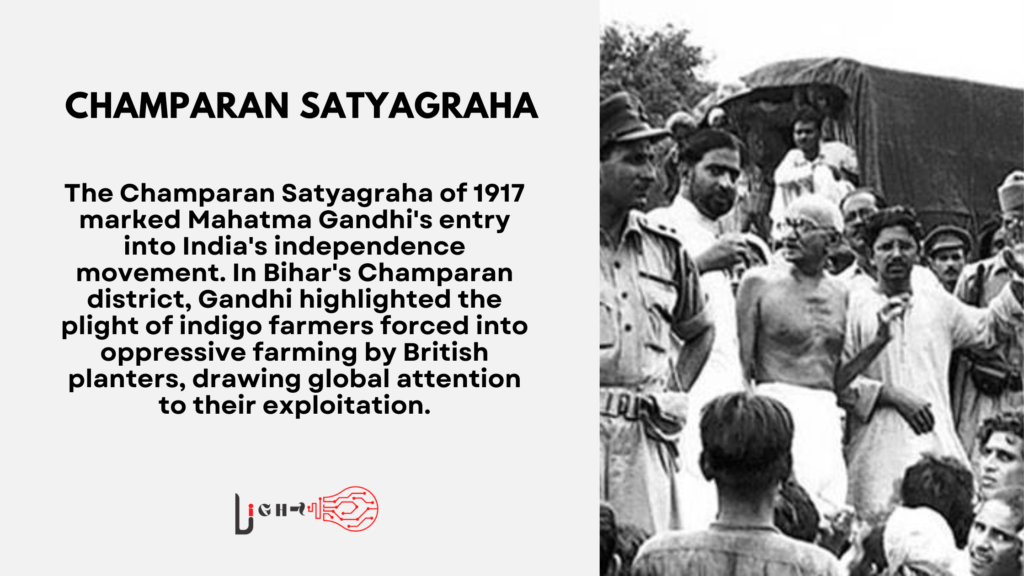The Champaran Satyagraha marked the beginning of Mahatma Gandhi’s influential role in India’s independence movement. In 1917, Gandhi’s involvement in Champaran, a small district in Bihar, brought global attention to the exploitation faced by Indian farmers under British rule. This movement emerged in response to the struggles of indigo farmers who were forced to grow indigo under oppressive conditions by British planters.
Through this movement, Gandhi introduced the concept of nonviolent resistance, or Satyagraha, in India. The Champaran Satyagraha is significant as it not only empowered local farmers but also laid the foundation for future protests that shaped India’s struggle for independence.
Understanding the Background of Champaran Satyagraha
The origins of the Champaran Satyagraha lie in the British planters’ exploitation of local farmers. Indigo, a cash crop highly sought in the international market, was enforced upon the farmers by the British under a harsh system called the Tinkathia system. This system required farmers to use a portion of their land exclusively for indigo cultivation, often leaving little space for other crops necessary for their survival.
As a result, farmers in Champaran were financially strained and often trapped in cycles of debt. With minimal profits from indigo and little control over their land, they faced severe poverty and starvation. The Tinkathia system not only devastated their livelihoods but also denied them any legal means to fight the injustices. Understanding their helplessness, Gandhi saw an opportunity to use his principles of non-violence to support their cause.
Mahatma Gandhi’s Role in Champaran Satyagraha
Mahatma Gandhi’s journey to Champaran began when he was invited by local leaders to investigate the farmers’ plight. Upon his arrival, Gandhi observed the severe oppression faced by the indigo farmers and began organizing the movement with a peaceful approach. His commitment to non-violence and truth gave him the moral authority to resist the colonial government’s oppressive practices.
Exploring Asia: A Journey Through Culture, Geography, and History
To know more click here:https://light.vintbit.com/general-knowledge/asia-largest-continent-world/
Gandhi mobilized the local population, conducted surveys, and documented the farmers’ grievances. Through open dialogues, Gandhi empowered the farmers to voice their concerns without fear. His presence in Champaran inspired widespread support and attracted volunteers from different regions. Gandhi’s leadership in Champaran became a template for subsequent movements, demonstrating how organized, peaceful protests could confront colonial oppression.
Key Events of the Champaran Satyagraha
The Champaran Satyagraha involved several significant events that showcased the effectiveness of peaceful protest in colonial India. Gandhi’s arrival, his interactions with the farmers, and his eventual confrontation with the British authorities all highlighted the power of non-violent resistance.
Arrival in Champaran
When Gandhi arrived in Champaran, he was immediately confronted by British officials who attempted to prevent him from meeting the farmers. Despite being ordered to leave, Gandhi chose to stay, marking his first act of civil disobedience in India. His defiance quickly gained the attention of both the local population and the British administration.1
Interactions with Indigo Farmers
Gandhi’s interactions with the indigo farmers were essential to building trust within the community. He listened to their struggles and documented their grievances, which later became critical evidence in legal battles against the British. Gandhi’s approach helped unite the farmers, empowering them to stand against the oppressive Tinkathia system.
Outcomes and Significance of the Champaran Movement
The Champaran Satyagraha resulted in several positive outcomes for the indigo farmers. Following Gandhi’s intervention and growing public support, the British were compelled to abolish the Tinkathia system. Farmers were granted greater freedom to choose their crops, improving their economic stability.

Champaran was a defining moment for the Indian independence movement. It demonstrated the power of peaceful resistance and set a precedent for future non-violent protests. Gandhi’s success in Champaran highlighted the potential for collective action to challenge injustices, inspiring freedom fighters across India.
The Tinkathia system
The Tinkathia system was a form of indigo cultivation enforced in Champaran, Bihar, during the British colonial era. Under this exploitative arrangement, tenant farmers were obligated to grow indigo on a specific portion of their land, usually 3/20th of their total holding. European planters, who had secured short-term leases from the Bettiah Raj, the second-largest zamindari in the area, introduced the system to maximize profits. They rented the land at low rates and coerced tenants into cultivating indigo, often providing fixed payments per bigha only when the crop yield was favorable.
However, if the crop was not abundant, these payments were significantly reduced, further straining the farmers’ livelihood. If farmers failed to grow the required indigo, they faced heavy penalties for breaching the contract. This system led to severe economic and social exploitation, fueling widespread dissatisfaction and unrest among the cultivators.
Legacy of Champaran Satyagraha in Indian Independence
The legacy of Champaran Satyagraha continues to resonate in Indian history as a pivotal moment in the independence movement. This protest solidified Gandhi’s leadership and brought international attention to the Indian struggle for freedom. Champaran showcased the effectiveness of nonviolent resistance and helped Gandhi establish his philosophy of Satyagraha as a powerful tool against colonial rule.
Gandhi’s work in Champaran paved the way for subsequent movements like the Salt March and Quit India Movement, which further mobilized the nation. Champaran Satyagraha remains an enduring symbol of India’s journey towards independence, serving as a reminder of the transformative power of peaceful resistance.

